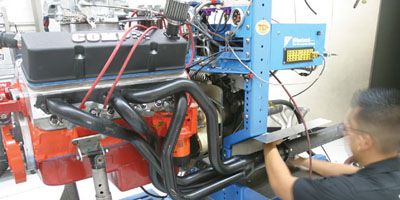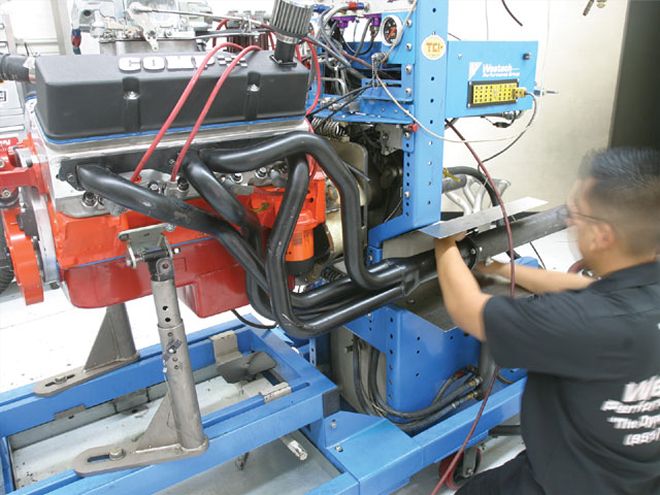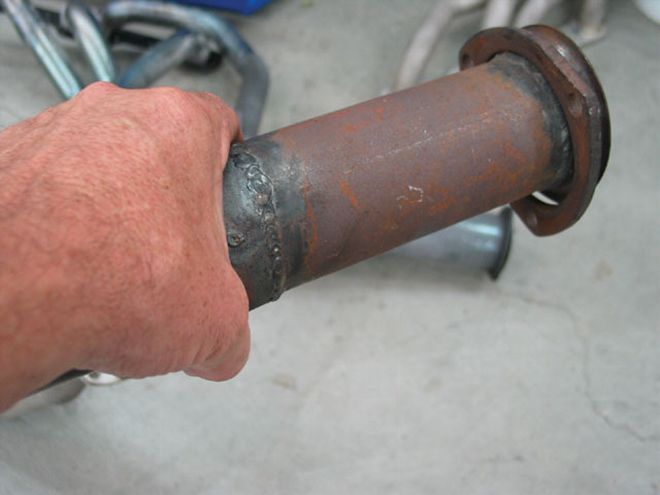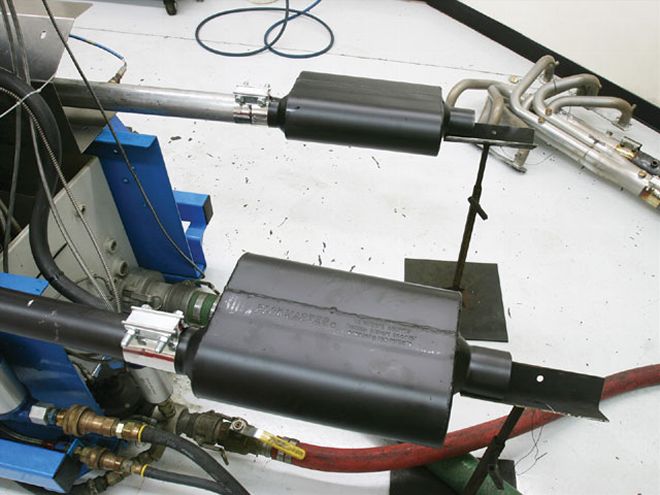
 We tested a set of Hedman 11/4-inch chassis headers both with and without collector extensions to evaluate the effect of the extensions on overall power, and the results were amazing.
We tested a set of Hedman 11/4-inch chassis headers both with and without collector extensions to evaluate the effect of the extensions on overall power, and the results were amazing.
The performance world is full of good tuning ideas. One place that is often overlooked in the search for more power is the exhaust system. For decades, knowledgeable drag racers have been using header collector extensions to improve torque, so we decided to test that idea on our hot street small-block.
The premise was simple enough. Stick an engine on the dyno and run a couple of headers with and without collector extensions and see what happens. This exhaust test involved using our trusty dyno-proven and Westech-flogged 383 small-block Chevy. With lots of valve timing and overlap, our roller cam motor made as much as 530 hp with a set of chassis-style 1 1/4-inch headers. Since this was a header test, at first we decided to run the engine without mufflers. Our first test ran without collector extensions compared to a second test with a set of 18-inch collector extensions installed. The difference was staggering.
This got us to thinking about larger exhaust systems and how a 3-inch system might be an advantage even for a 450hp engine, because the larger-diameter exhaust is in some ways just like a long collector extension. We've also included a dyno test that first appeared in the September issue, but this time we're looking at it from an overall power standpoint. When we quizzed Flowmaster muffler guru Kevin McClelland, he suggested necking the system back down to 2 1/2 inches before entering the muffler to limit the noise that occurs from 3-inch systems. The results may not surprise you if you've been around high-performance engines for a while. But if this is your first foray into the wild world of hot gas tuning, this should be an eye-opening experience.
The Test Engine
We used the 383ci small-block Chevy from the September issue for this test because the little Mouse just loves to run. The short-block retains the same Lunati 4340 steel rotator with its excellent 4340 steel Pro Mod rods and Wiseco forged pistons. We did change things up a bit with the XR286 Comp mechanical roller only because we didn't want to spin our little motor all the way to the moon just for a header test. That will come later. Completing the Comp valvetrain are the same Endurex roller lifters, Comp Magnum 1.5:1 rocker arms, and roller valvesprings. We stayed with the alpha-dog Dart 227 CNC heads, however, and also retained the Holley Keith Dorton single-plane intake manifold. We did do some minor alterations with a move to a larger Barry Grant 850-cfm Mighty Demon carburetor. Combined with the Hedman 1 1/4-inch headers, a fresh set of Bosch spark plugs, and our requisite MSD distributor, we were ready to test.
 This collector extension is nothing more than a length of 3-inch pipe welded to a simple collector reducer. If you're a good scrounger, you can probably build a pair of these for free. Otherwise, Summit Racing sells the parts for under $30 to build a pair of extensions.
This collector extension is nothing more than a length of 3-inch pipe welded to a simple collector reducer. If you're a good scrounger, you can probably build a pair of these for free. Otherwise, Summit Racing sells the parts for under $30 to build a pair of extensions.
Length Does Matter
If you look at a typical set of V-8 street headers, there is a large tube that connects all four primary pipes called a collector. Most collectors are relatively short, roughly 4 to 8 inches in length. The collector ends with a flat flange used to connect to the rest of the exhaust system. The baseline for Test 1 ran a budget set of 11/4-inch headers that feature a relatively long 8-inch collector. For Test 2, the only thing we did was bolt on two 18-inch-long collectors.
Between 3,100 and 4,500 rpm, the additional collector length was worth a maximum of 59 lb-ft of torque at 3,900 rpm. In between these rpm points, the average torque increase was more than 34 lb-ft. If you consider that this rpm band is the flash rpm point for a typical street torque converter, adding 30-plus additional pound-feet of torque has got to drastically improve the 60-foot times. We also evaluated the power averages of both rpm curves from 2,500 to 6,700 rpm. The collector extensions won that battle too, with a better horsepower curve and an additional average increase of 9.7 hp. Just to support the effect of a collector extension, we performed a second test using a smaller set of Hedman 1 1/4-inch primary tube chassis headers. With these headers, the collector extension increased the torque between the 3,500- and 4,800-rpm band with a maximum gain of 26 lb-ft but also an average of 14 lb-ft of torque over that entire 1,400-rpm span.
Test 1 is Hedman 1 3/4-inch headers without the collector extensions. Test 2 is the same headers with the 18-inch collector extensions.
TEST 1 TEST 2 DIFFERENCE RPM TQ HP TQ HP TQ HP 2,500 398 189 376 179 -22 10 2,700 395 203 370 190 -25 -13 2,900 392 216 378 209 -14 -7 3,100 384 227 398 235 +15 +8 3,300 381 239 418 263 +37 +24 3,500 385 256 434 289 +49 +33 3,700 392 276 450 317 +58 +31 3,900 401 298 460 341 +59 +43 4,100 429 335 466 363 +37 +28 4,300 455 373 475 388 +20 +15 4,500 477 408 482 413 +5 +5 4,700 488 437 487 435 -1 -2 4,900 491 458 490 457 -1 -1 5,100 489 475 491 477 +2 +2 5,300 484 489 486 491 +2 +2 5,500 476 499 478 501 +2 +2 5,700 465 504 470 510 +5 +6 5,900 452 508 461 518 +9 +10 6,100 441 513 452 525 +11 +12 6,300 433 519 440 528 +7 +9 6,500 425 526 425 526 0 0 6,700 412 526 411 524 - -2 Peak: 489 526 491 528 59 43 Average: 434.9 386.1 446.7 395.8 11.8 9.7
Averages were calculated over the entire power curve with data taken every 100 rpm.
 A Flowmaster-muffled 3-inch exhaust system compared to a 2 1/2-inch system was worth more midrange torque than peak horsepower but is still a solid idea for any engine making over 450 hp.
A Flowmaster-muffled 3-inch exhaust system compared to a 2 1/2-inch system was worth more midrange torque than peak horsepower but is still a solid idea for any engine making over 450 hp.
Muffled Power
The open-header test led us to question whether this same collector extension concept would apply with a muffled system. That's when we realized that we'd already performed that test when we evaluated the difference between a 2 1/2- and 3-inch exhaust-pipe system using Flowmaster Super 44 mufflers. The following data indicates that the larger 3-inch pipe system is worth roughly an average of 5 lb-ft of torque and horsepower throughout the entire powerband. The best improvements on our 383 small-block occurred between 4,900 and 5,500 rpm with 11 lb-ft of torque and 11 hp, and there was only one small place in the torque curve where the larger pipes lost 4 lb-ft of torque. At first we attributed this power gain to reduced exhaust backpressure, but now we think that it may be a combination of less backpressure and tuning effects that increase airflow through the engine. Also, it could be that adding an H- or X-pipe in the system in the proper place actually enhances the torque curve even more, possibly eliminating that slight power drop in the 3-inch system at around 3,900 rpm.
2 1/2-inch vs. 3-inch Exhaust With Mufflers Test
FlowmasterFlowmaster
2½-INCH 3-INCH RPM TQ HP TQ HP TQ HP 2,700 385 198 390 200 +5 +2 2,900 400 221 404 223 +4 +2 3,100 418 247 424 250 +6 +3 3,300 427 268 437 274 +10 +6 3,500 433 288 435 290 +2 +2 3,700 430 303 428 301 · · 3,900 423 314 419 311 · · 4,100 421 328 417 326 · · 4,300 426 349 429 351 +3 +2 4,500 440 377 446 382 +6 +5 4,700 455 407 463 414 +8 +7 4,900 461 430 471 439 +10 +9 5,100 462 449 473 460 +11 +11 5,300 459 463 470 474 +11 +11 5,500 453 474 463 485 +10 +11 5,700 445 483 454 493 +9 +10 5,900 438 492 444 499 +6 +7 6,100 431 501 433 503 +2 +2 6,300 422 506 424 508 +2 +2 6,500 407 504 411 509 +4 +4 Peak 462 506 473 509 +11 +11 Average 432.8 381.0 437.9 385.7 +5.1 +4.7
This test was performed on the same 383ci small-block Chevy, but it was configured with a larger Comp Cams XR292 mechanical roller cam and a smaller 750-cfm Street HP Holley carburetor. The headers for this test were also different, employing a set of Hedman 1 3/4-inch chassis headers.
What's It All Mean?
There are tons of car crafters who uncork their exhaust because their car runs quicker at the dragstrip with open headers. If your engine is equipped with a big cam with lots of overlap, adding a set of collector extensions will probably improve the midrange torque. The reason is that when the exhaust pulse from the open exhaust valve arrives at the collector, a reflected wave of low pressure travels back up the collector and all the way back to the cylinder. If this low-pressure wave arrives at the cylinder during overlap, when both the intake and exhaust valves are open, it creates an additional "tug" on the inlet side of the engine, filling the cylinder. The timing of this reflected wave at a given rpm is determined by the design of the exhaust system. Adding collector length requires the exhaust pulse to travel farther before hitting open air. Shortening the overall length of the collector changes the timing of that reflected wave's arrival at the cylinder. It means less scavenging of the exhaust during this time, which means more residual exhaust gas in the cylinder and less power. This is why the torque increased with the longer collectors between 3,100 and 4,500 rpm.
When we tested the 3-inch muffled exhaust system on this engine, it unfortunately was not the exact same engine configuration. Perhaps most importantly, the headers were of different design and length. But we can still draw some thought-provoking conclusions. For example, adding a muffler creates a small amount of backpressure that certainly reduces the effect of the reflected wave, since it is not as intense as it would be if it were to exit into the atmosphere. Plus, our 3-inch exhaust pipe leading to the muffler was roughly three times longer than the 18-inch collectors used on the open-exhaust test. However, it appears that most 450-plus-horsepower engines will respond with positive torque gains when upgraded to a 3-inch exhaust system. The next step would be to experiment with H- and X-pipes to see what effect these designs have on torque and horsepower. Keep in mind that this was an experiment on just one engine and, as the saying goes, your results may vary.